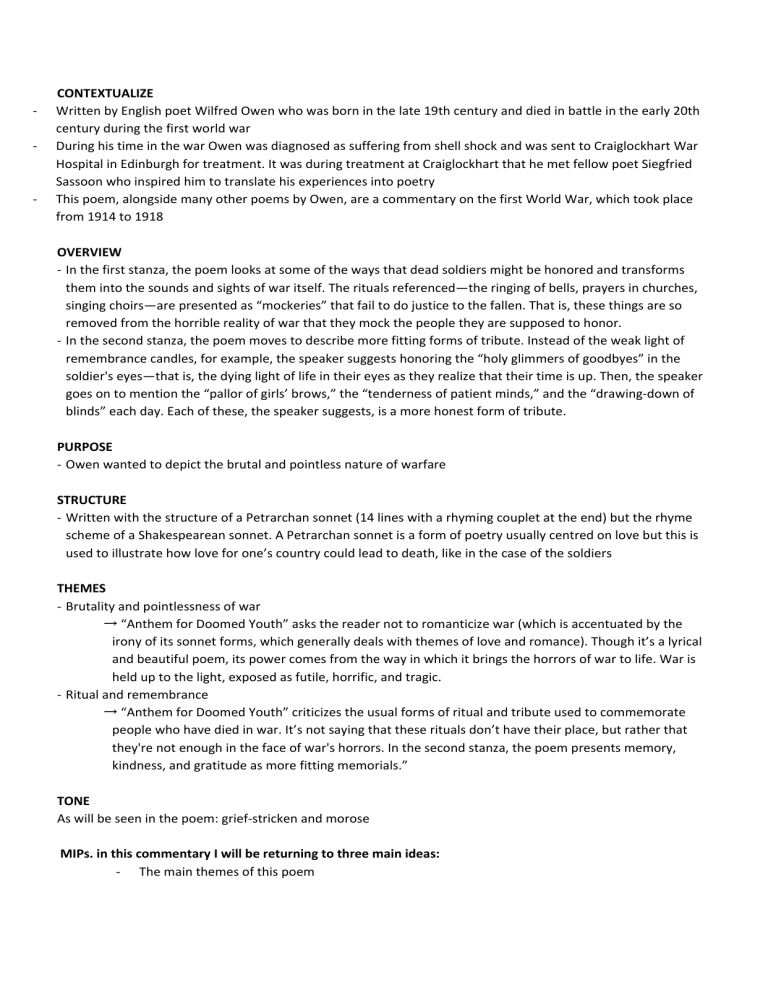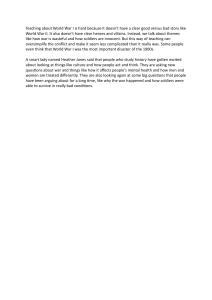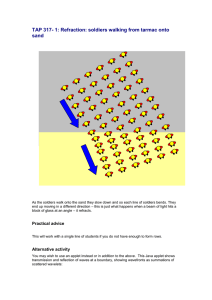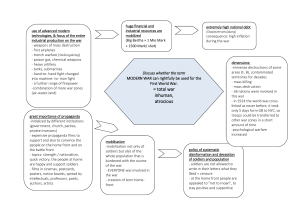
- - CONTEXTUALIZE Written by English poet Wilfred Owen who was born in the late 19th century and died in battle in the early 20th century during the first world war During his time in the war Owen was diagnosed as suffering from shell shock and was sent to Craiglockhart War Hospital in Edinburgh for treatment. It was during treatment at Craiglockhart that he met fellow poet Siegfried Sassoon who inspired him to translate his experiences into poetry This poem, alongside many other poems by Owen, are a commentary on the first World War, which took place from 1914 to 1918 OVERVIEW - In the first stanza, the poem looks at some of the ways that dead soldiers might be honored and transforms them into the sounds and sights of war itself. The rituals referenced—the ringing of bells, prayers in churches, singing choirs—are presented as “mockeries” that fail to do justice to the fallen. That is, these things are so removed from the horrible reality of war that they mock the people they are supposed to honor. - In the second stanza, the poem moves to describe more fitting forms of tribute. Instead of the weak light of remembrance candles, for example, the speaker suggests honoring the “holy glimmers of goodbyes” in the soldier's eyes—that is, the dying light of life in their eyes as they realize that their time is up. Then, the speaker goes on to mention the “pallor of girls’ brows,” the “tenderness of patient minds,” and the “drawing-down of blinds” each day. Each of these, the speaker suggests, is a more honest form of tribute. PURPOSE - Owen wanted to depict the brutal and pointless nature of warfare STRUCTURE - Written with the structure of a Petrarchan sonnet (14 lines with a rhyming couplet at the end) but the rhyme scheme of a Shakespearean sonnet. A Petrarchan sonnet is a form of poetry usually centred on love but this is used to illustrate how love for one’s country could lead to death, like in the case of the soldiers THEMES - Brutality and pointlessness of war → “Anthem for Doomed Youth” asks the reader not to romanticize war (which is accentuated by the irony of its sonnet forms, which generally deals with themes of love and romance). Though it’s a lyrical and beautiful poem, its power comes from the way in which it brings the horrors of war to life. War is held up to the light, exposed as futile, horrific, and tragic. - Ritual and remembrance → “Anthem for Doomed Youth” criticizes the usual forms of ritual and tribute used to commemorate people who have died in war. It’s not saying that these rituals don’t have their place, but rather that they're not enough in the face of war's horrors. In the second stanza, the poem presents memory, kindness, and gratitude as more fitting memorials.” TONE As will be seen in the poem: grief-stricken and morose MIPs. in this commentary I will be returning to three main ideas: - The main themes of this poem - How Owen utilizes weaponry in the poem as a way to comment on the brutal and pointless nature of warfare The ways in which Owen highlights the mistreatment of soldiers in the war LINE-BY-LINE ANALYSIS Anthem for doomed youth - Irony: “anthem,” is used ironically as well, because an anthem expresses unity and functions as a celebratory and happy hymn, whereas in this case, it is bitterly sarcastic since there is a large amount of grief being conveyed in the poem. It is, then, a kind of protest poem—subverting the usual use of “anthem” as a symbol of nationalism (that is, taking undue pride in your home nation) into an anti-war message. - Had originally had “dead” instead of “doomed” in the title, changed it to create greater sense of helplessness as it seemed that the youth’s fate was sealed What passing-bells for these who die as cattle? - Religious imagery: “passing bells,” – religious imagery to allude to funeral bells – implying that the soldiers are dead. - diction: “these,” his diction is used to create detachment between reader and soldiers to represent how the government thought of them as commodities, as “these,” is a demonstrative pronoun. - Simile: “as cattle,” – to represent how the soldiers are dying in “herds” on the frontline like animals in a slaughterhouse. It also compares their treatment (like the lack of a funeral) to the treatment of cows, expressing the extent to which soldiers have been dehumanised - Rhetorical question: Opens with the rhetorical question. This rhetorical question provokes reader thought, making readers question why the soldiers are not given funerals – shock the readers to the realities of war and how the soldiers’ deaths are taken. - Hypophora: The rhetorical question acts as a hypophora given that the question is asked at the beginning of the stanze and is answered in the rest of the stanze. - The speaker questions what good "passing-bells"—and other forms of ritual—really do in the face of such indiscriminate slaughter. In other words, this first line introduces the idea that there is too much of a disconnect between the pretentious symbolism of religious ceremony and the grim realities of warfare. Only the monstrous anger of the guns. Only the stuttering rifles' rapid rattle - Personification: “monstrous anger of the guns.” – expresses the chaos and pandemonium of the soldiers’ deaths – juxtaposed to the peaceful deaths that people think they deserve and the contents of the first line. This signifies the beginning of the use of auditory imagery throughout the poem which acts, in a way, to replace the absent “passing-bells” - Personification: “stuttering rifle,” to add to the sense of chaos and express the rage of the person holding the rattle, as stuttering is something people do when they are infuriated, hence the expression, “stuttered with rage,” – sense of chaos created and this is juxtaposed to the peaceful deaths that people think they deserve and the contents of the first line - Anaphora: Lines 2 and 3 make similar points. They are both about the sounds of war, and both begin with anaphora of the repeated "Only", which aids in Owen’s emphasis on the personification of the weaponry that heavily juxtaposes with the rest and silence which one may expect for a nation’s soldiers when they die - Alliteration: “rifle’s rapid rattle,” – alliteration of ‘r’ sound emphasises the stuttering previously mentioned and reinforces the rage of the enemy – sense of chaos– juxtaposed to the peaceful deaths that people think they deserve and the contents of the first line. Can patter out their hasty orisons. - Onomatopoeia: “patter,” – onomatopoeia that sounds like gun firing. The soft sound of "patter" is deliberately out of place here, helping to portray actual prayers (and traditional responses to soldiers' deaths more generally) as, essentially, meaningless utterances. - Diction: “hasty orisons,” – hasty means rushed, connotes a lack of care, shows how little effort went into the last rites of the men as metaphorically represented through the word orisons, which is an archaic term for prayers. Expressing his disheartenment with the church to the public, while reinforcing the theme of death. No mockeries now for them; no prayers nor bells; Nor any voice of mourning save the choirs,— - Parallelism: “No mockeries…no prayers nor bells.” – the mockeries are the prayers and bells, this parallel is reinforced by the repetition of the word no before each of the words. Owen is saying that the funerals performed glorify their deaths, since they die like cattle. This is also an extension of Owen’s own negative view of the church for aiding the government in performing the shoddy funerals that are not fit for honourable soldiers and also for persuading men to go to war, as the churches preached pro war propaganda. - Diction: use of ,”nor,” and ,”no,” in the same line create a sense of deprivation, highlight how the soldiers have a lack of amenities and essentials on the battlefield, increase pity for soldiers - Caesura: The caesura partway through makes line 5 feel a little slower and more mournful as well, compared with the brutal depictions of the first half of the stanza. - Explicit message: Line 5 makes the poem's stance on remembrance rituals explicitly clear: "passing-bells," "orisons," "choirs" and so on are all "mockeries." That is, rather than paying tribute to fallen soldiers, they're actually more of an insult—because they're so divorced from the reality of warfare. The shrill, demented choirs of wailing shells; - Metaphor: The "choirs" of line 6 are, in fact, the horrific sounds of the "shells" (explosive and deadly projectiles) as they rain over the soldiers' heads. These sounds are metaphorically described as "shrill, demented choirs," like a choir from hell singing in praise of death and destruction. - Personification: idea of a choir (peaceful, serene) juxtaposed to the adjective used (demented) mocking the divinity and peace that is presented by the Church. This enhances the continued criticism of Church by Owen. And bugles calling for them from sad shires. - Volta: the volta is the turn of thought or an argument in a sonnet. This is seen in line 8 because the poem's setting shifts from the "theater" of war (the area where the conflict actually takes place) to the country from which the soldiers in question originally came. Whereas lines 1 to 7 showcase the horrible and hellish of sounds weaponry, the sound (that of a bugle, which is a simple brass instrument) in line 8 instead relates specifically to home. - Diction: “bugles,” – Bugles were commonly used on the front lines of war to convey instructions or information but they also have a commemorative use. The speaker evokes this commemorative use of bugles by characterizing their tune as the melodic sound of loss and longing - Sibilance: “sad shires,” – alliteration to emphasise how the shires (different parts of Britain) are very sure that their men will die in the war, morose tone created. This also emphasizes Owen’s criticism of war and its pointlessness What candles may be held to speed them all? - Synecdoche in candles which are used as funeral imagery to represent remebrance as a whole - Rhetorical question: implies that no candles are used to send them into the afterlife, no proper funeral. This question acts as a hypophora once more as it is asked at the beginning of the stanze and is answered in the rest of the stanza. - Religious allusion: Speed - religious allusion given that the speaker asks what candles can help the souls of the dead find their way ("speed") to the afterlife Not in the hands of boys, but in their eyes - Diction: “boys,” – shows how young the soldiers are and how innocent they are (denotation), increasing the tragedy of their deaths. - “in their eyes,” – implies tears, shows that tears are more genuine expressions of grief than the superficial funerals - Religious imagery: “hands of boys,” – religious imagery related to funeral because altar boys carry candles to the casket during funeral - Litote; not in the hands of boys, but in their eyes. Allows Owen to put emphasis on what isn’t happening instead of what is. Shall shine the holy glimmers of goodbyes. - Euphemism: “holy glimmers of goodbye,” – (conveys their suffering) euphemism for suffering of soldiers before they die, showing how the soldiers died without honour, because the glimmers form when people are about to cry, hence explaining that they were crying before they died. You only cry if you’re really suffering emotionally, reiterating the theme of suffering and therefore increasing the audience’s sympathy for the men - Sibilance: Line 11—makes use of sibilance (both alliterative and consonantal) to create a whispering quality that's suggestive of weakness as life ebbs away: The pallor of girls' brows shall be their pall; - Definition: “pall” is a cloth laid over a coffin—but again, many of these young men won't have funerals, which means that they won't have coffins over which a pall could be draped. - Multiple meanings: “Pallor” has a kind of double meaning—it relates to being pale, but can also mean "deathlike." In other words, the "girls' brows" have been touched by death in their own way. Through this image, the speaker suggests that the profound grief of those left behind is actually a more fitting way to honor the dead than any of the formal rituals discussed in previous lines. Their flowers the tenderness of patient minds, - Diction: “flowers,” reinforces existing funeral imagery to highlight a sense of tragedy. Instead of the temporary beauty of "flowers," the sacrifices of WWI will be honored by peace. - “tenderness of patient minds,” – the speaker hopes that part of the sorrowful legacy of the war will be "the tenderness of patient minds." That is, the speaker hopes that one of the effects of such a devastating war will eventually be to make such an event less likely in the future. And each slow dusk a drawing-down of blinds. - Diction: dusk refers to the time period during which soldiers could relax and rest. It is also the last part of the day and this could parallel how the soldiers’ lives are ending and in their end, the soldiers can finally be at peace. This punctuates the theme of death and adds to the morose tone of the extract. - Allusion: “drawing-down of blinds.” – practise when one’s family member died, home had blinds drawn to honour the dead. This adds to the morose tone of the last line by showing how at dusk, more blinds are drawn, i.e more dead soldiers. - Sibilance: Both lines in the couplet use sibilance, drawing the poem to its hushed close.




